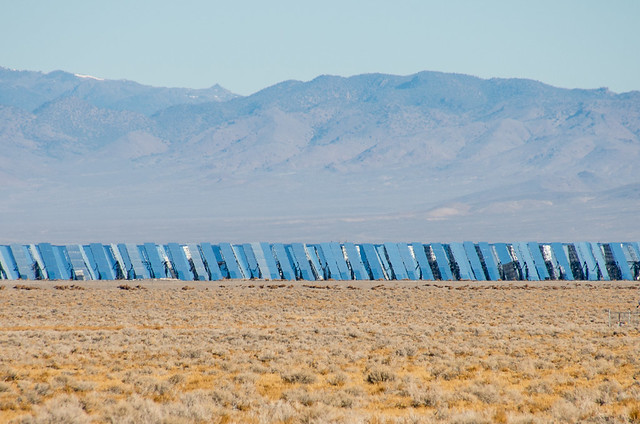 |
| Solar Reserve (integrated storage), California |
Wind and solar energy generation has surged over the past few years. Although renewables still lag far behind fossil fuels in total generation, the balance is shifting in their favour. In 2014, solar generation in the US almost doubled, while wind generation outgrew all other sources.
Increased use of solar and wind energy has been handicapped by one major roadblock. On a sunny, windy day, you can generate lots of renewable energy, perhaps more than you need, but there’s been no easy way to store excess energy. That problem may be a thing of the past as businesses, such as Tesla, generate new and better energy storage batteries.
Tesla Powerwall
The launch of Tesla Energy’s Powerwall earlier this year generated a huge amount of interest. They were sold out to mid-2016 within a week in the United States. (The batteries should be available in Canada at the beginning of 2016.)
The Powerwall, available in both residential and commercial sizes, can store energy from your solar panels, store energy during off-peak periods when it’s sometimes cheaper, and act as a backup power source if there’s a power outage.
Tesla plans to build the batteries in a fully solar-powered plant and to source raw materials from North America, which should reduce energy consumption during production and increase transparency.
Residential Energy Storage
Tesla’s storage units are designed to even out supply and demand, providing independence from the grid and the dirty energy sources that power the grid. The batteries could also be helpful in areas that experience frequent power outages or areas that offer reduced energy rates in off-peak periods.
Brent Veitch of Rock Paper Sun hopes that the batteries will make households more aware of how much energy they consume. If you’re limited to 10 kWh of energy storage, you may decide that you don’t need a beer fridge in the garage and can hang your laundry outside to dry rather than draining your battery using an energy-guzzling clothes dryer.
Brent also hopes that the availability of storage batteries will encourage more people to invest in solar panels.
Solar panels and storage batteries are still expensive, so you may never see a financial return on your investment. If you have a net metering arrangement with the local energy provider and can sell your surplus energy back to the grid, storage batteries become even less financially viable.
From a financial point of view, energy conservation measures (installing LED lights, insulating your home, buying energy-efficient appliances) may be more cost effective than purchasing a storage battery.
Brent wonders if an international company such as Tesla will have a negative impact on the local economy (similar to shopping at Costco rather than the local farmers’ market). On the other hand, if Tesla chooses to work with local renewable energy companies, it could have a positive impact.
 |
| Singapore's solar-powered supertrees |
Industrial Energy Storage
Hawaii’s utility rates are the highest in the United States because most of their electricity is generated using imported crude oil. That situation could change as Hawaii has set a goal of generating all of its electricity from renewable energy sources by 2045. They’ll be using a variety of energy storage methods, including batteries, to even out supply and demand.
California is also emphasizing energy storage: “Major utilities there are required to install 1,325 megawatts of energy storage — enough for about 1 million homes — by 2024 as one step toward fighting climate change.”
Con Edison, which supplies power to New York City, plans to use energy storage to take advantage of solar generation by individual households in residential areas. “Con Edison is working with several New York State agencies and New York City to streamline permitting of battery storage systems within the city. It also is developing its first utility-scale battery power storage system, a 1 megawatt battery storage facility in Queens,” according to Michael Leff, Con Edison’s resource planning analyst.
Impact on the Grid
For, many years, energy providers such as SaskPower have had a monopoly on the provision of energy. They have ensured equality by providing service to all parts of the province, but they have also had sole control over the sources of energy, which in Saskatchewan has been primarily coal. Alternate energy sources (residential solar panels, district energy programs) are breaking the monopoly.
Storage batteries provide individuals and communities with an additional tool to use in choosing and controlling their energy supply. It will be interesting to see what impact this has on power utilities.
Further Information:
Tesla Powerwall: What you need to know
Will Tesla’s home battery really transform our energy infrastructure?
Big Batteries, Energy Storage Key to Renewables’ Future
Distributed Generation Poses Existential Threat to Utilities
June 21, 2015 addition - Beyond the Tesla Powerwall: How Energy Storage is Shaping up in Ontario
